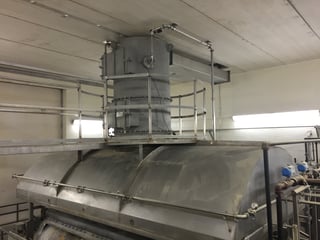 Sourcing a dust collection system means considering a variety of factors: wet or dry, efficiency levels, space constraints, pressure levels, energy consumption and more. Another question that engineers have to consider is whether to buy an off-the-shelf dust collection system or configure a custom-designed solution for your facility. This issue requires careful consideration and thoughtful review of the pros and cons of each approach.
Sourcing a dust collection system means considering a variety of factors: wet or dry, efficiency levels, space constraints, pressure levels, energy consumption and more. Another question that engineers have to consider is whether to buy an off-the-shelf dust collection system or configure a custom-designed solution for your facility. This issue requires careful consideration and thoughtful review of the pros and cons of each approach.
Regulatory Requirements
One of the factors that weigh heavily in the custom vs. off-the-shelf question is dealing with regulatory requirements. NFPA, EPA or OSHA regulations can be quite stringent. For example, if the exhaust gasses must contain particulate contaminants below a certain threshold, and you choose to go with an off-the-shelf solution, it may not be able to meet those requirements.
Regulatory requirements can include OSHA mandates against silica dust, NFPA mandates on removing explosive dust and particulate matter like flour, and EPA regulations that prohibit the exhaust of heavy metals, toxic gasses, and environmental contaminates into the air. These may require specialized filters, airflow patterns, physical space constraints and other considerations that many off-the-shelf systems may not be able to accommodate.
Unusual Applications
Another consideration for your next system involves reviewing your application.
One particular approach calling for custom solutions might be if materials recovery is needed. Say, for example, your setup involves working with titanium or another valuable metal that is cut, sanded, or otherwise aerosolized as part of your process. In these situations, the dust that is created is not merely waste. Rather, it is a valuable material, and its recovery is vital.
For these setups, materials recovery requires a higher level of equipment design. Custom solutions offer the opportunity to use very specific filters/cartridges, pre-cleaners, intakes and exhausts and collectors to make sure that metals are filtered and captured. Off-the-shelf systems may lack these necessary components.
On the other hand, don’t go overboard to the custom mind-set and make the mistake of assuming your system must be one of a kind. There are very few systems that do not have some precedent or related system already in the field. While it may not feel that way during the detailed process of system design and engineering, do not be shy about asking a supplier or colleague if they have seen a similar setup to yours before.
Be Aware of Changed Quoting Processes
If you opt for a custom solution, be aware that selecting a vendor and particular unit does change the quoting process by adding time and complexity to the whole process.
A custom system quote has to define every aspect of the unit, such as types of dust/gasses to be filtered, airflow patterns, space constraints, energy consumption and regulatory compliance/performance, as well as cover accessories. It can be a lengthy list, since everything custom needs to be spec’d:
- Temperature gauges
- Humidity monitors
- Air pressure sensors
- Filter media
- Solenoids
- Pressures
- Solenoids
- Paints/Coatings/Finishes
- Spouts
- And more
These typically are already defined in a standard system installation, but custom often starts from a blank sheet sheet of paper.
If you are going custom, ensure your quote takes into account elements “outside” the dust collection system. These typically include plumbing, ductwork, vent hoods or pickups. For those components, custom quotes may specify working with a complementary vendor or subcontractor, so the final system is sure to include source these sub-systems in a way that ensures compatibility with the core collector or scrubber.
The quoting process for custom dust collection systems is far more collaborative and back-and-forth than the conventional quoting process, for good reasons. If you are not accustomed to ordering dust handling systems, then designing a custom solution may mean relying more on the experience and engineering support of your supplier than with a standard offering. However, if you are a seasoned “dust designer” and know what works for your application, you will likely have less back-and-forth and will be able to specify more of the system than a customer installing his or her first few systems.
Also, remember to consider total lifetime performance requirements of the system. For detailed, complex, or highly-specialized setups, maintenance and operations costs can be different when comparing standard vs. custom. Special filter media can be more costly, or compressed air and energy consumption costs can vary, for example.
Sly works closely with our customers with custom dust collection solutions. You can rely on our 143+ years of expertise to design the right system for you. Request a quote or call us at 1-866-72-3545 for more information.
Tags: dust collection system




